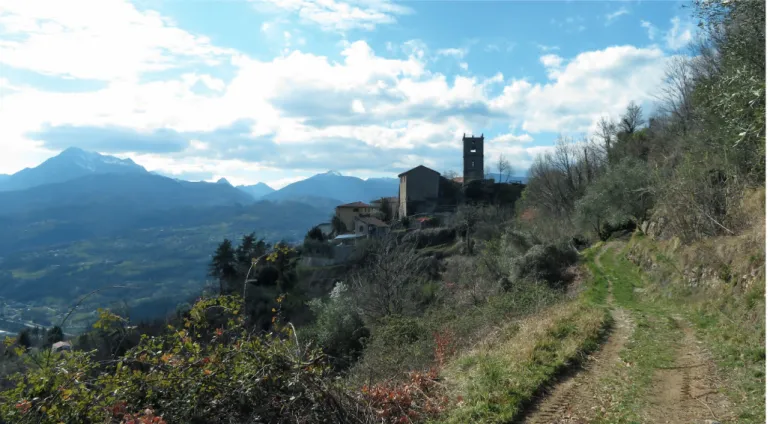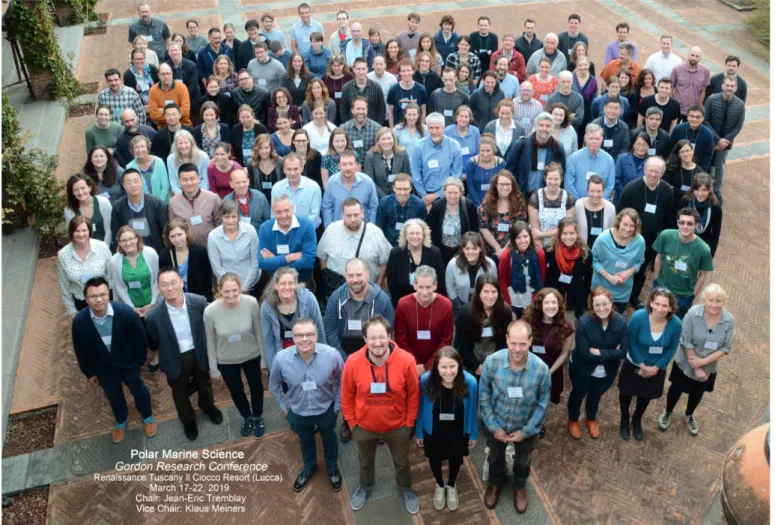161 Polarforschung 88 (2), 161 – 162, 2018 (erschienen 2019)
Conference Report for „Polarforschung“:
Gordon Research Seminar & Gordon Research Conference on Polar Marine Science in Barga, Tuscany
16 – 22 March 2019
by Christian Katlein (Chair, Gordon Research Seminar on Polar Marine Science 2019)
____________
Keywords: conference, polar marine science doi:10.2312/polarforschung.88.2.161
Manuscript received 8. April 2019; accepted 13. May 2019
The Gordon Research Conference on Polar Marine Science is a highly interdisciplinary conference running a very special conference format. In 2019 this off-the-record meeting was held at the “Il Ciocco” resort in the beautiful mountains of northern Tuscany. The remote site was a perfect venue for the special format of this conference featuring on-site accommo- dation, common meals and free-time during the afternoons.
Gordon Research Conferences (GRC) – an American char- itable non-profit organization – organizes this meeting since over two decades every two years, to bring together leading scientists from all disciplines in polar marine science. The
special format and off-the-record policy provide for an inti- mate and inspirational week targeted at the development of the field as a whole, bridging links between different disciplines.
Also this year, a line-up of inspiring invited speakers guar- anteed a glimpse onto the forefront of polar marine science.
Conference chairs Jean-Eric Tremblay and Klaus Meiners organized a very diverse and interesting conference program (https://www.grc.org/polar-marine-science-conference/2019/) under the theme “Shedding Light on the Physical, Biogeo- chemical and Human Dimensions of Connectivity in Changing Polar Seas” which covered a wide range of topics encompassed in polar marine science. As the GRC policy encourages the presentation of unpublished recent results, and the discussion of more provocative or daring research hypotheses, especially the extensive poster sessions provided the 130 participants with many new ideas, how their specific research fits into and can advance the bigger picture of the climate and ecosystem
Fig. 1: Free afternoons allowed for nice excursions with colleagues in the sunny mountains of northern Tuscany. Photo: C. Katlein Abb. 1: Freie Nachmittage erlaubten den Teilnehmern schöne Exkursionen in die sonnigen Berge der südlichen Toskana. Foto: C. Katlein
162
Fig. 2: Group photo of all Gordon Research Conference on Polar Marine Science 2019 participants. Photo: GRC Abb. 2: Gruppenphoto aller Teilnehmer der Gordon Research Conference on Polar Marine Science 2019. Foto: GRC
of both polar oceans. The free afternoons inherent to the GRC format allowed attendees to enjoy the great weather, both in intense scientific discussions on the hotel terrace, during an excursion to the walled city of Lucca, or walks on the trails winding through the sunny vineyards. Great local Italian food and Tuscan wine turned the common meals into a memorable experience, where even shy PhD students ended up talking to leading scientists of the field.
Since 2011, this Conference is also accompanied by the Gordon Research Seminar on Polar Marine Science, which provided 50 early career researchers with a warmup day before the start of the main GRC conference. It gave young researchers the possibility to present their talks and posters in a protected atmosphere to the generation of their main future collaborators. The Seminar also provided valuable insights into career options and choices during a career panel, where senior members of the community shared their views and tips for a successful academic career. After an intense and thought provoking conference in Tuscany, the community is already
looking forward to the next Gordon research Conference on Polar Marine Science, which will be held in Ventura, Cali- fornia in March 2021.
We particularly want to thank the DGP (Deutsche Gesellschaft für Polarforschung) for their generous finan- cial support, which allowed us to cover the registration costs of the Gordon Research Seminar for four German early career scientists. Overall, we were happy to receive a record breaking amount of financial contributions that allowed supporting registration costs for 22 early career scientists.
In addition to the DGP we thus sincerely thank the Gordon and Betty Moore Foundation, the International Glaciolog- ical Society, Fluid Imaging Technologies Inc., RBR, ASL Environmental Sciences, the Norwegian Polar Institute, the Alfred-Wegener-Institute, the Swiss Polar Institute, Univer- sité Laval, SCAR, IASC, Québec Océan, Sentinel North and Polar Knowledge Canada for their financial contribution supporting early career scientist participation in this unique conference.

